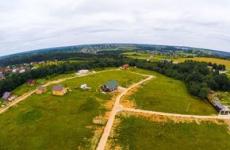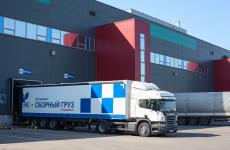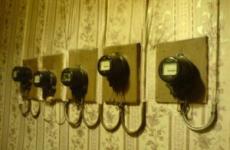Swa antenna amplifier wiring diagram. All about antenna amplifiers. Antenna amplifier setup
Not so long ago, our market was flooded with Polish antennas from Anprel, Teltad and many others (the official name is ASP - 4WA, ASP - 8WA, CX-8WA, the popular name is "" dryer "" or "" grid ""). As practice has shown the use of such antennas, the design itself does not withstand any criticism - plastic construction crumbles almost the next year after the introduction of the antenna into operation. But the electronic part, with all its simplicity, is quite reliable - it is afraid only of moisture and static electricity during the period of spring and summer thunderstorms.
There are two different types of video signals that your television can receive via an antenna. Although you need two different types of antennas, you can buy a computer with two receivers. This will allow you to easily get all the available television stations in your broadcast area as soon as you have an antenna installed on your television.
You will need a place to move the antenna, so make sure you are in a big place to make adjustments. Connect the antenna to the wall outlet if it has a power amplifier. Often these amplifiers can get better images than an independent standard antenna.
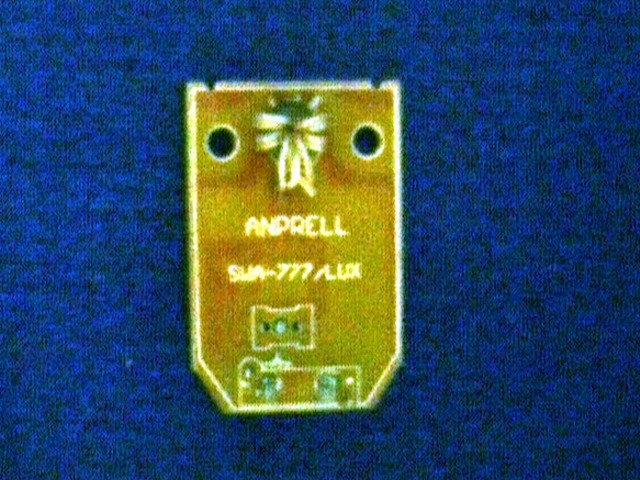
To make a hidden antenna, we will need: an amplifier power supply (preferably with adjustable output voltage; by varying the supply voltage, we can adjust the gain of the antenna amplifier), the SWA amplifier ( the right amplifier It is selected according to the gain / noise and reception range from the transmitting center), antenna cable, electrical cable (wire) with a section of 0.5 - 2.5 sq. mm, terminals and insulators, as well as a piece of nylon cord for stretching. The power supply and amplifier can be purchased at any radio store or radio market for a nominal fee of 100-150 rubles. All other components are available in the household of each homemade man. Antenna we produce from two segments of the electric wire with a length of approximately one meter.
Take the coaxial cable that goes from the back of the antenna to the TV. Make sure the cable is securely connected, otherwise you may lose audio and video signals. Turn on the TV and antenna. To improve image quality and filter out noise from your television frequency bands, a television signal amplifier placed at the antenna output can help you get the best reception your antenna cannot provide. For residential television systems, two types of signal amplifiers are available - a preamplifier and a distribution amplifier.
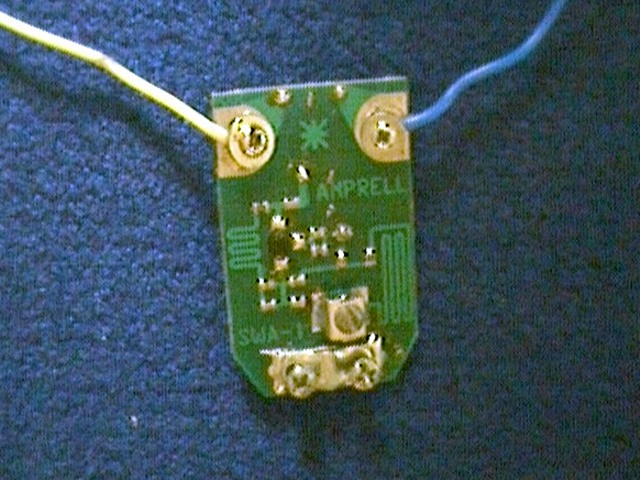
On the one hand, to the ends of the wires we solder the terminals (under the M4 bolt with a nut), on the other hand we fasten the insulators. Insulators can be taken ready (if you have ceramic nuts in your “stock”) or you can make plastic, plexiglass, etc. from pieces of any dielectric. For mating insulators fasten stretch marks of nylon cord. Next, fasten each of the arms of the antenna sheet to the pads of the amplifier (see photo), fasten the antenna cable (according to the standard SWA amplifier connection) first to the amplifier, then to the separation filter of the power supply unit (plug).
The first is usually called the “preamp”. This type of amplifier consists of an actual amplifier, which is located in the antenna and a power source inside the house. It is usually ideal for reception in snowy or granular situations. is a type of amplifier that is commonly used to distribute television signals to several places. Transmission amplifiers can have one or more splitters built into the amplifier. They can be designed to increase open channels or cable channels.
The following are tips for installing a signal booster. However, in cases where you need to use a television signal amplifier for multiple devices, place it in close proximity to the antenna divider. If you only need to amplify the signal to the device, install a preamplifier near your TV. You can mount the signal booster on the inside wall or place it horizontally. The effectiveness of your television signal booster depends a lot on your design and installation location.
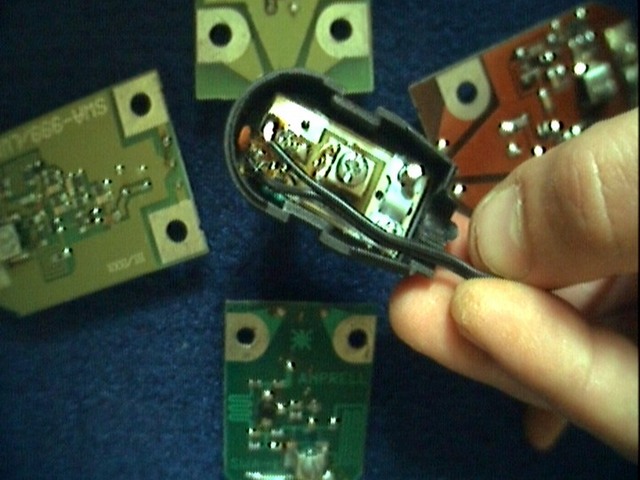
Everything - the simplest antenna is ready. It remains only to fix and adjust the antenna in the attic of a country house or a barn. A little about the roofing material - no roofing material (except iron) for the operation of such an antenna is an obstacle. As practice has shown, the antenna perfectly accepts even high-frequency decimeter channels at a distance of 15-25 km from the transmitting center! By the way, in the same way you can upgrade and indoor antenna - it is enough to remove the matching-balancing device from it and put the amplifier with the power supply. You can also upgrade street antennas, just take measures to seal the antenna amplifier from precipitation and reliably ground the structure (static protection). If the upgraded antenna is a full-wave antenna (such as Delta 311-01 or similar) that has an MV-UHF matching and balancing device, then it is advisable to leave the standard matching device and remove the matching transformer (see photo) for connection to the amplifier and make a connection from the standard antenna matching directly to the amplifier circuit. It is interesting to upgrade the amplifiers themselves, with the replacement of standard transistors for more low-noise and powerful.
Some are better indoors, while others are better outdoors. Consider obstacles near your home, such as trees, walls, pipes, reservoirs and buildings, among many others, which can lead to weak television signal or other admission problems. Therefore, it is imperative to understand their needs in order to select suitable reinforcement. You can also call the technician to complete the installation.
In this case, the installation must be performed at the highest point of the building. After the antenna is well positioned, the signal will descend down the coaxial cable and be distributed to all residents in order to have access. With a cable in the apartment just plug in the TV. However, in some households the signal may be slightly weak due to this sharing.
Antenna amplifier is a device that is installed on the antenna in order to enhance the signal and, consequently, improve the quality of the picture on the TV screen. It will be especially relevant in the area far from the TV towers. As a rule, these are villages and villages far from civilization.
It is important to help a professional in this process. He will know how to scale the need for one or more signal amplifiers. Simply connect to a shared antenna system and search for channels. To ensure the strength of the signal, it is necessary to verify the need for equipment, such as amplifiers.
If the antenna is not ready, it may be necessary to replace it with a suitable model. If the signal distribution is not adequate, installation of amplifiers on all floors may be required. Of course, consult the antenna. Who should pay for the adequacy of the antenna in my condominium? Condominium is financially responsible for all costs associated with adaptation collective antenna to digital signal. As a rule, these values are proportional to the owners of condominiums. But it is only now in deployment.
Installing an antenna amplifier is necessary to improve the quality of the signal.
The reasons for poor signal reception can be many. Even residents of large cities face such a problem, although it would seem that they are in close proximity to the towers. The most common causes of interference:
- signal source is too far from the receiving point;
- obstacles in the signal path - trees, high-rise buildings, etc .;
- landscape dip between the point of reception of the signal and the tower;
- weak signal.
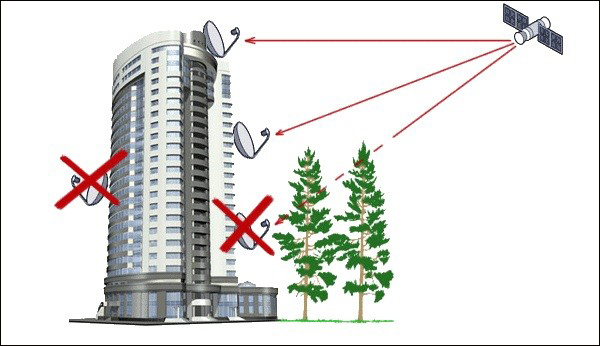
Do not forget to read the rules, convention and internal rules to know how this should be done in your condominium. Who can install the collective antenna? An antenna is a specialist. A good professional will conduct a technical assessment of the condominium and give all the necessary instructions, from checking the ability to receive a signal to the correct installation of all equipment.
When it comes to audio, the main problems that we usually encounter can be divided into. Watch our video below on how to connect cables and equipment. If you still have questions, check out our suggestions for how to solve them.
The choice of antenna amplifier depends on many factors. However, the first thing you need to understand - what kind of antenna is installed. There are two types of them: passive and active. In the design of the active antenna is already built into the default signal amplifier. If you have problems with the signal, then, most likely, you are the owner passive antenna. Such an antenna should be installed only if the transmitting signal tower is within sight and there are no obstacles between it and the antenna.
In some situations, the sound, raised, can create a frequency imbalance, making it very high, low or medium. A number of problems can cause this imbalance. Of the problems in connection with the technique and quality of equipment used in the seizure, you should check.
Immune impedances can lead to a loss of high frequencies, for example, to the sound “muffled” and “dead” or “thin” and without sustain. This happens with instruments that have an output impedance greater than the input impedance of the audio interface and an unbalanced signal, such as: keyboards, guitars, electric guitars, basses, and instruments that have a common sensor.
The next thing to find out is the distance to the nearest tower.
TIP. Depending on the distance to the tower, you should choose a device with a suitable gain. Usually buy antenna amplifier It is only provided that the distance from the tower to the house is more than 10 km. If the distance is less, then the problem is in the wrong antenna and the position amplifier will not fix it.
There is no other way out, except for a complete check of the signal chain. Defects and wear can cause both an imbalance in frequencies and uncomfortable noises. Many devices operating from a single source of electrical current may require higher power than it can provide. This leads to heat and fluctuations that could jeopardize the proper functioning of the equipment, which leads to poor sound signal processing. Stabilizers can also exhibit this problem. A common example is guitar pedals connected to the same source.
Gain is a characteristic with which you need to be careful. This is the case when it no longer means better. With a lack of signal will not be strong enough, and with an excess of noise will appear, which still will interfere with high-quality broadcast. For this reason, for one type of antenna produce many models of amplifiers with different characteristics.
Bad sound and acoustic problems
Often you can detect the frequency of disharmony without any problems with the connection or electrical signal, but since the sound source was raised. For more information on this subject, see where we approach the subject of acoustics and abstraction in more detail.
Nothing could be more annoying to a home studio owner than this constant loud noise that eliminates the quality of any recording. Some common causes of noise. In ungrounded outputs, it is not possible to eliminate noise from the electrical system and network components such as computers, amplifiers, and sound tables. Make sure your system is grounded and grounded.
For the correct choice of the coefficient it is necessary to use a special table. There is nothing complicated about it.
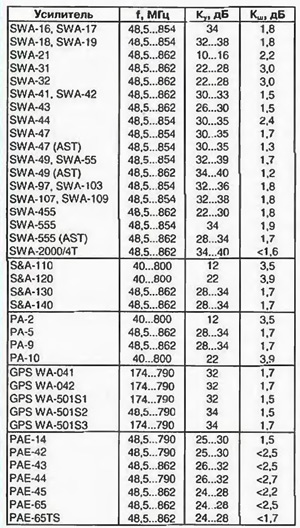
Types of amplifiers
We will not go into the subtleties of the antenna amplifier design - for the average person this information will be useless. We will tell about two types of amplifiers and their purpose.
This may seem confusing, but excessive grounding can also be a problem, especially when providing grounding between equipment connected by balanced cables. This problem arises differently: when there are different ground rods for different outputs and when two grounded devices are connected to each other. In both cases, the current that must flow to the ground is confronted by a less resistive path and circulates between the two devices, causing an “antenna effect” that will convert any interference.
SWA Amplifier
SWA antenna amplifiers are used in ASP-4 and ASP-8 lattice-type antennas, which are often referred to as “Polish” antennas. By themselves, these antennas have a very low gain, and without an amplifier, they can not do.
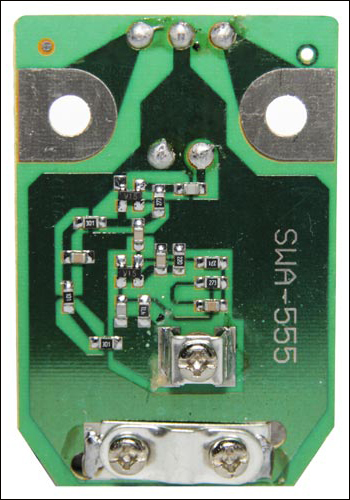
To resolve this problem, make sure that the equipment is connected to the same grounding panel. If not, plug them all into one outlet with a stabilizer. If they are already connected to the same grounding system, some solutions. Some devices have this option that interrupts the grounding of balanced cables that connect equipment. Another option is to use a 3-pin plug adapter on one of the devices, but it should be used only if there is a connection between different devices, returning to use 3 pins when connected separately. There are devices that interrupt the direct connection between the equipment and its ground. They cause the signal to pass through a transformer that is electromagnetic inductance and does not conduct ground current, interrupting the ground circuit. If you are using a laptop, you can use a double-insulated power supply without grounding. Remember that this is only a functional solution if a cycle occurs between a laptop and another device.
- It is also possible to ground the symmetrical cables connecting the equipment.
- Insulators.
- Double insulation.
The two most important characteristics when choosing an amplifier SWA will be - the gain and noise figure. When buying, pay attention to them. About the first we have already spoken above. The second is still simpler - the smaller, the better.
LSA Amplifier
This type of amplifier has a very narrow scope. They are produced for the repair of failed locus antennas. Certain LSA models can enhance their corresponding Locus antenna models.
Also avoid positioning the cable on other equipment, and if you need to put it on the power cable, maintain a 90º angle between them. Avoid using high-powered equipment on the same network during recording, as this may cause interference to the power supply itself.
There is a possibility that the noise source is not electric. Keep as much silence as possible while recording, while avoiding the use of noisy equipment such as air conditioning, washer and even watch pointers. Another source of noise is vibration. Make sure that there are no objects in the recording area, such as: battery mats, furniture, doors and windows. Damaged speaker buses or amplifier cabinets with free parts can also cause this type of noise. Try to eliminate these vibrations by preventing, for example, that mobile, where the amplifier repeatedly strikes the floor.
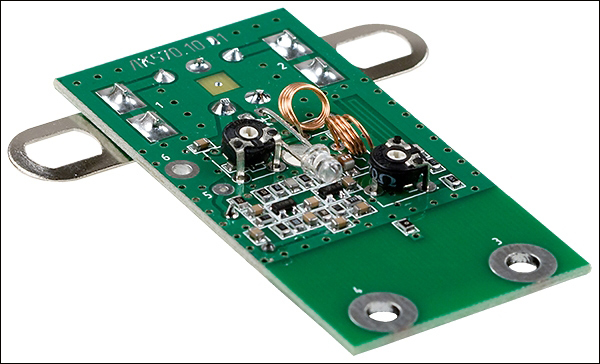
Power Supply
As a rule, the design of the antenna amplifier is equipped with a built-in power supply. The device is connected to the network and, due to its small power, consumes only about 10 watts. There are built-in and external power supplies. Built-in power supplies are low-power devices of small size. If the electrical network is unstable, they are of little use. However, if power surges are rare, it will be quite enough.
Another common problem is the electricity produced by electric companies. If you suspect this is happening, contact your local utility to verify the stability of the supply. If your equipment uses a very high current, to the point of oscillation, it is recommended to use a stabilizer.
A bad electrical installation can also jeopardize electrical current. Incorrectly connected phases can increase the mains voltage above the maximum supported by the equipment. The capture process must be careful. Whenever you encounter a problem of noise or noise, be systematized.
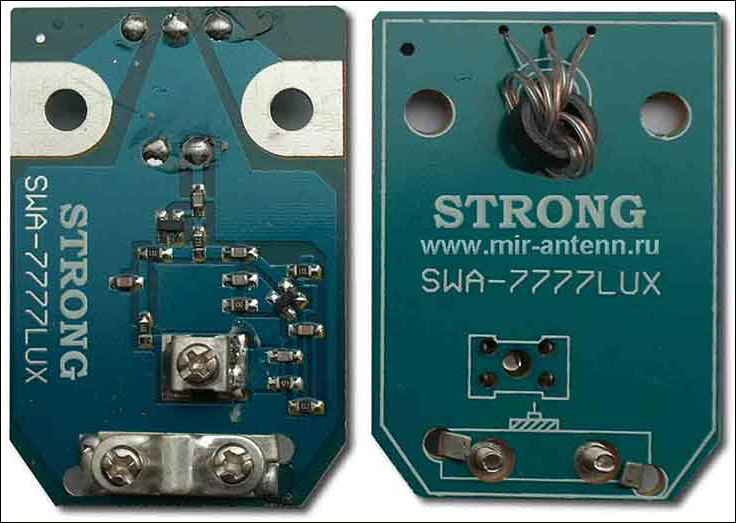
External power supplies are large in size and power consumption. They provide stable operation of the antenna amplifier even in an unstable network. Such power supplies are designed for different input voltages: 5, 12, 18, 24 V. This parameter should exactly match the supply voltage specifically for your amplifier.
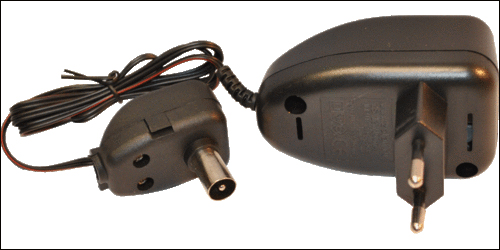
Antenna amplifier setup
Externally, the amplifier is a small electronic circuit. It is attached directly to the antenna itself with bolts and nuts. The amplifier will show greater efficiency if it is installed near the antenna on the mast, between the matching device and the feeder. The signal passing from the antenna through the feeder significantly reduces its level. After installation, you need to check whether the signal has improved. Without equipment, this can be done simply by turning on the TV.
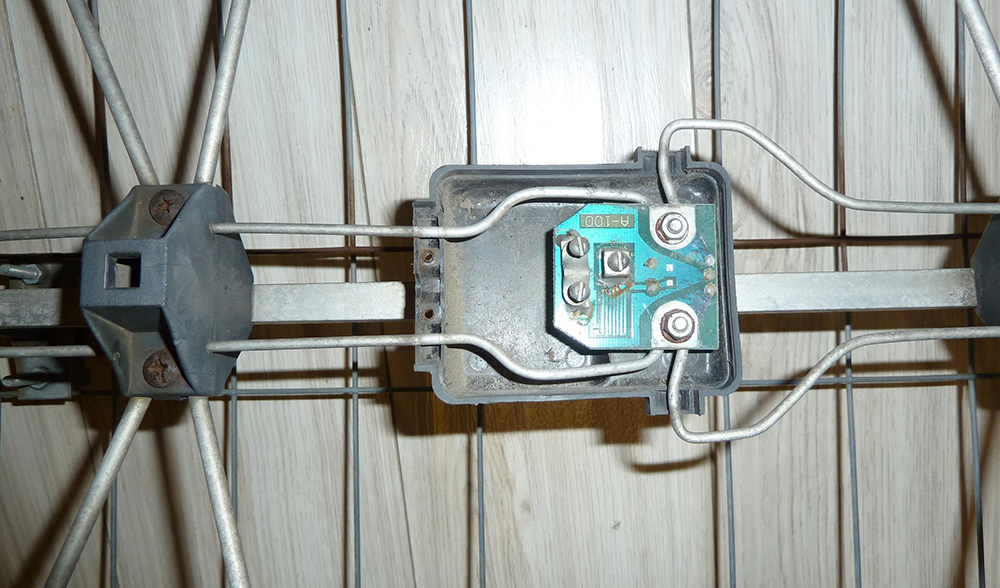
If the antenna is already installed, it is not difficult to connect the amplifier and, using a special adapter, to power the power supply. However, if the antenna is not connected, then you will have to be puzzled by holding the cable to the TV. If you are not sure of yourself, then the best solution is to call a telemaster who quickly and efficiently performs this task.
Connect TV cable to TV
The first step is to choose tv cable. This is a very crucial moment, since even an expensive TV will not provide you with a high-quality picture without a properly selected wire.
The most common on the market are coaxial cables from various manufacturers with a characteristic impedance of 75 Ohms of the brands RG 6U, SAT 50, SAT 703B and DG 113. The stamps are listed in order of increasing quality. Marking is applied to the cable sheath along the entire length.
IMPORTANT. We will not describe all existing antenna cables, since this is not possible. However, please pay attention to the following - the cable must have an impedance of 75 Ohms and the outer diameter of the shell must be at least 6 mm. By adhering to these two criteria, you can find the right cable.
Once you have chosen a cable, you must connect it to the plug, since you cannot connect bare wires to the TV. In our time, the most widespread F-plugs. Plugs of three different sizes are available for cables of different diameters. Be careful when buying - make sure the plug fits your cable. After the purchase will install a plug. This can be done according to the scheme below.
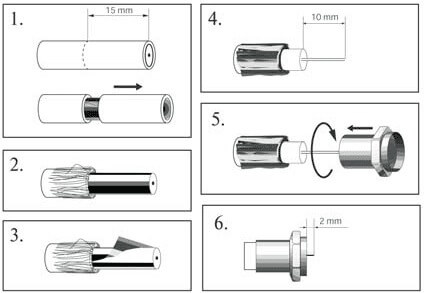
Antenna ground
However, this is not all. Before using the antenna must be grounded. This is a very important and responsible procedure, and it should be approached with great responsibility.
IMPORTANT. Be careful! In the previous stages, the maximum that you could spoil is the cable. When grounding, there is every chance of getting an electric shock - which could be fatal. Therefore, in no case do not try to do the grounding yourself! Call the master, who will do everything quickly and efficiently.
If you live in an apartment building, as a rule, the antenna will be installed on the balcony or loggia. In such cases, there is no need for grounding, since it is already provided for when building a house. Current will be grounding in a private house or at the dacha.
That's all. In this article, we talked about existing species antenna amplifiers and how best to install them. We hope the article was informative and helped you in this difficult question.

